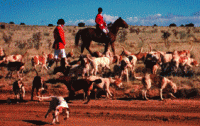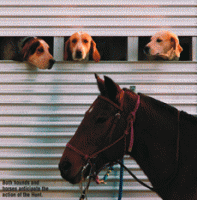New Mexico- Foxhunting in the Southwest



By Judie Framan
Photos by Elliot Framan and Lindsey Green
Getting up in the dark has never been my favorite thing to do. In fact it’s near the bottom of the heap of covers where I like to linger until first light. Only a few times has leaving the comfort of my bed before dawn proved enticing: to ride along a pristine beach in Costa Rica catching the sunrise over the Pacific Ocean; to watch the migration of the gray whales; to catch the bullet train from Paris to Provence for horseback riding in Van Gough country.
All that has changed since I discovered foxhunting, and joined the Juan Tomas Hounds hunt club. The exhilaration of opening hunt is unsurpassed by any horseback experience that I can remember. On a crisp damp fall morning in October we gather at the fixture (hunt field) for opening hunt. The weather bodes well for good scenting conditions, and the air is laced with anticipation as hunters, horses and hounds prepare for the chase. The hounds, tails wagging, mill around waiting for the sound of the huntsman’s horn that signals casting time. The horses, manes and tails braided, coats shining in the early morning light, snort and prance eager to be off. The gentlemen hunters in red coats and women in black coats sit their mounts quietly listening to instruction from the Master. All are silent so as not to alert our quarry, El Coyote. And then we are off, following the hounds, waiting for them to find a scent and give voice.
Every Thursday and Sunday morning during the months of October through March, members of the Juan Tomas Hounds meet to enjoy their sport and the companionship of other horseback foxhunters. Hunting is quite the family affair in New Mexico. With 100 members ranging from 6 years old to 90 years old, you are likely to see plucky youngsters riding along side seasoned hunters, all with the purpose of hunting the wily Coyote. The horses of the Juan Tomas Hounds vary in breeding and size from Thoroughbreds to Arabians, American Saddlebreds, Tennessee Walkers, Paso Finos, cow horses, and warmbloods. We even have a hunting mule. The qualities of a good field hunter are not its size or breeding. The most sought after horses are solid, even-tempered and have the staying power to carry the day.
Much has been written about foxhunting in England over the past few years, the final drama playing itself out in the House of Lords that banned foxhunting forever in The British Isles. Our American heritage of foxhunting dates back to colonial days, and was enjoyed by farmers and landed gentry alike. Our first president, George Washington, kept a pack of hounds and hunted several times a week.
Over the years, foxhunting in North America has evolved into its own distinctive flavor, much different from the British sport. Today, people in all walks of life enjoy foxhunting: ranchers, teachers, nurses, doctors, pony club members, and college students. The truth in North America is that we emphasize the thrill of the chase rather than the kill. What brings hunters out week after week, sometimes in inclement conditions, is the companionship of like-minded people, the traditionalism of the sport, and the exhilaration of riding in the glorious New Mexico countryside. “One of the first questions we are asked is “do you kill the coyote,” said Jim Nance, Master Juan Tomas Hounds and a Regional Director of the Masters of Fox Hounds Association of America. “My reply is that if we only wanted to kill them, we would use a gun. We always have a wonderful time hunting even on a day that we never see a coyote.”
The Thrill of the Chase
The term foxhunting can apply to the red fox, gray fox and coyote, and what you hunt depends on what area of the country you are in. In the southwest, we follow the hounds on horseback as they follow the coyote, often at a fast pace. The coyote is hunted rather than the fox, because the coyote is in such abundance here. By contrast, the coyote is bigger, stronger, faster, and cleverer than the fox. Each coyote has its own pattern that it will run when being pursued.
Riders in the hunt are divided into two or three groups called fields. The first field follows the hounds as closely as possible. Riders in this field should be able to jump. The second field riders need not jump, and follow at a moderately fast pace. Third field follows at a slower pace. New members are assigned to the third field until the field master assesses their riding ability and their horses’ behavior.
When a hound finds the scent and gives voice, hunters, horses and hounds thrill at the opportunity to run. At this point, the hounds catch the line (scent) and they are off. This is what the riders and horses have been waiting for, and it takes little encouragement to join in the chase and watch the hounds work.
The hounds are the stars because they love their job. Their keen sense of scent and instinct is the backbone of the hunt. Developing a pack of hounds that measures up to the Master of Foxhounds Association (MFHA) standards is no easy task. The Juan Tomas Hounds got its name from the small village of Juan Tomas, New Mexico where the hounds were first kenneled. They trace their lineage back to colonial days and beyond. Both American and English foxhounds are the basis of the Juan Tomas pack, which is the result of over 30 years of selective breeding, cross breeding and training. The result of this immense outpouring of time, effort and knowledge is a pack of hounds that is effective for the New Mexico terrain and scenting conditions over which they hunt.
The Master is the decision-maker and responsible for the days sport. The staff (Huntsman and Whippers-in) help the Master manage the hunt. It is the Huntsman who is responsible for training the hounds. When hunting, the Huntsman signals the hounds with a hunting horn, which indicates where to cast and when to pack up. Specific voice commands are used with the hounds as well. The Whippers-in maintain order within the pack and round up any hounds that may strike out on an independent hunt of their own. The drag Whipper-in brings along hounds that stray from the pack. The Field Master is responsible for the riders, making sure to keep the field close enough to enjoy watching the hounds, but not so close that they interfere with them.
Hunting Attire
People who do not hunt, often scratch their heads at the attire worn by foxhunters. There are reasons why this ageless dress code is adhered to even today. One of the key reasons foxhunters wear a particular garb is the tradition. Riding habits have changed little since foxhunting began centuries ago. Wearing the habit is the way we show respect for one another and for the sport. Another reason is that the clothing is designed to be practical under hunting conditions. Plus, it is fun to wear hunting garb.
The formal dress code for foxhunters consists of black leather boots, breeches, a hunting coat, shirt with a stock tie and protective headgear. The heavy boots and breeches, which are worn inside the boots and fit like a second skin, protect the rider from becoming entangled in branches and underbrush. The hunting jacket, which is usually made of Melton, is durable and almost waterproof. The stock tie, which is de rigor, is fastened with a simple stock pin of gold or silver. While not particularly attractive, the stock tie also serves as a bandage for the hunter, hound or horse in the event of an accident.
During formal hunting season the staff wears its livery – scarlet coats with white breeches and black boots with tan leather tops. In most hunts, lady masters, field masters and gentlemen members also wear red coats. Red is worn because it is obvious and can be seen at a great distance by riders who may have fallen behind. The rest of the members who follow the field wear black coats, buff breeches and black boots. On informal hunt days or during cubbing season, riders wear “ratcatchers” and traditionally styled earth colored attire.
The hard hat is undoubtedly the most important item of apparel. This velveteen- covered helmet protects the hunter from injury to the head when ducking under low-lying branches. And in the event of a rider parting company with his horse, it protects from serious head injury.
The End of the Hunt
After a day of fine hunting, riders, horses, and hounds return to the trailers where a sumptuous tailgate breakfast awaits. Relaxed now, hunters and their mounts follow the pack as the hounds snoop along. Around the campfire, the discussion turns to the day’s sport -- coyotes viewed or not, hunting conditions, the horses’ performance, the hunter who parted company from his horse and landed in the sagebrush. The magic that is inherent in this, one of man’s oldest sports, is evidenced in the smiles and camaraderie of the hunters.
While Equitrekking does not necessarily share the views expressed in this article, the experience is true to riding. Though great controversy surrounds the sport of hunting, in particular, fox hunting by horseback, it is a part of equestrian sports, and therefore, worthy of discussion. Our editorial board has reviewed this piece and found the value outweighed any controversy.
Purchase Equitrekking DVDs, the Equitrekking Travel Adventures on Horseback book and more at ShopDarley.com. Learn about equestrian vacations and book a trip at EquitrekkingTravel.com.




